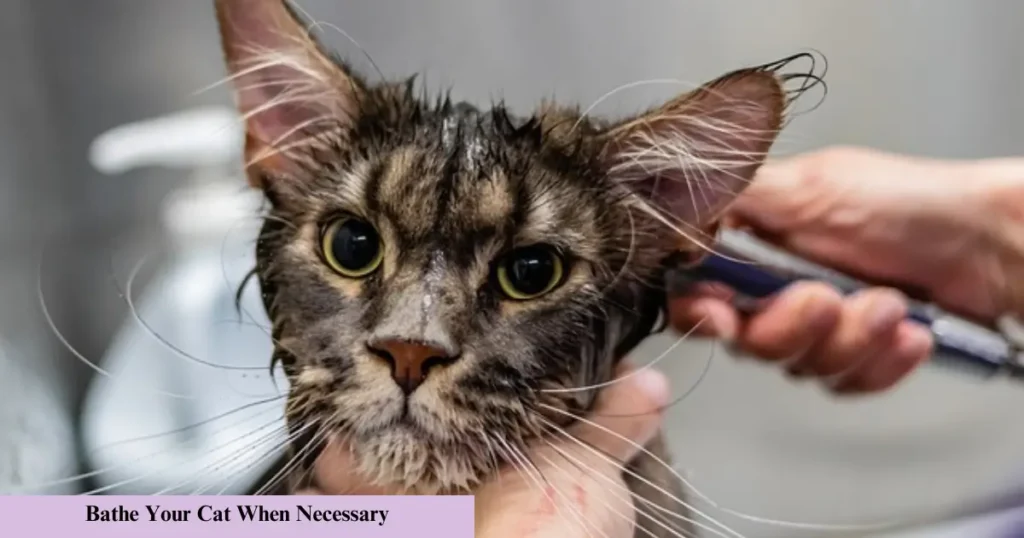Grooming your cat is not just about keeping them looking neat—it’s also essential for their health and well-being. Regular grooming helps prevent matting, reduces shedding, and keeps your feline friend’s skin and coat in top shape. It also allows you to spot potential health issues like fleas, ticks, or skin problems early. However, many cat owners worry about doing it incorrectly or causing their pet stress. The good news is, with the right techniques, you can learn how to groom your cat at home easily and safely like a pro. Grooming at home can strengthen the bond between you and your cat while keeping them comfortable and healthy.

How to Groom Your Cat at Home Easily and Safely
In this guide, you will discover seven expert tips to ensure a stress-free and effective grooming routine. Whether you’re dealing with a long-haired or short-haired cat, these easy cat grooming tips at home will make the process smooth and enjoyable for both you and your furry friend.
1. Create a Calm and Safe Grooming Environment
Cats are sensitive to their surroundings, and sudden noises or unfamiliar settings can make grooming stressful. Therefore, creating a calm and safe environment is the first step.
Steps to create a cat-friendly grooming space:
- Choose a Quiet Room: Pick a space with minimal noise and distractions. Avoid areas with loud appliances or sudden movements.
- Use a Non-Slip Surface: Place a towel or rubber mat on the grooming table or countertop to prevent slipping. This keeps your cat stable and reduces their anxiety.
- Good Lighting: Ensure the room is well-lit so you can easily see what you’re doing, especially when trimming nails or cleaning ears.
- Keep the Temperature Comfortable: Cats are sensitive to temperature changes, so ensure the room is neither too hot nor too cold.
Prepare the Tools in Advance:
Before you begin, gather all the grooming supplies you will need:
- A soft bristle brush or slicker brush
- Cat-safe nail clippers
- Grooming wipes or cat-safe shampoo
- Cotton pads and cat ear cleaner
- Towels for drying
✅ Tip: Groom your cat when they are calm, such as after playtime or a meal. This reduces resistance and makes the process smoother.
2. Brush Your Cat’s Coat Regularly
Brushing is a key part of DIY cat grooming techniques as it removes loose fur, reduces shedding, and prevents mats. It also distributes natural oils, giving your cat a shiny and healthy coat.
Brushing Tips by Coat Type:
- Short-Haired Cats: Brush once or twice a week with a rubber grooming brush or soft bristle brush. These brushes remove loose fur and minimize shedding.
- Long-Haired Cats: Brush daily with a wide-toothed comb or slicker brush. Long-haired cats are prone to tangles and mats, so frequent brushing prevents knots.
How to Brush Safely:
- Start with Gentle Strokes: Brush in the direction of hair growth to avoid pulling on the fur.
- Focus on Tangle-Prone Areas: Pay extra attention to areas behind the ears, under the legs, and around the tail, where mats often form.
- Use Detangling Spray: For stubborn knots, use a cat-friendly detangling spray to loosen the hair gently.
✅Tip: Regular brushing reduces hairballs by preventing your cat from swallowing excess fur while grooming themselves.
3. Trim Your Cat’s Nails Carefully
Overgrown nails can cause discomfort, hinder walking, and potentially lead to joint issues. To groom your cat at home safely, regular nail trimming is essential.
Steps for Safe Nail Trimming:
- Use Cat-Specific Nail Clippers: Avoid using human clippers, as they can splinter cat nails. Use sharp, high-quality cat clippers for clean cuts.
- Hold the Paw Gently: Press the paw pad softly to extend the nails. This makes them easier to trim.
- Trim the Tip Only: Cut just the sharp tip, avoiding the pink area (quick). Cutting into the quick may result in bleeding and pain.
- Take Your Time: If your cat resists, trim one or two nails at a time and take breaks to avoid stress.
✅ Tip: If you accidentally cut the quick, apply styptic powder or cornstarch to stop the bleeding.
4. Clean Your Cat’s Ears Gently
Healthy cat ears should be pink and free of odor, redness, or excessive wax. Regular ear cleaning helps prevent infections and removes debris.
How to Clean Cat Ears at Home:
- Use a Cat-Safe Ear Cleaner: Choose a gentle solution specifically made for cats.
- Dampen a Cotton Pad: Soak a cotton pad or ball with the cleaning solution.
- Wipe the Outer Ear: Gently wipe the visible part of the ear, removing wax or dirt.
- Avoid the Ear Canal: Never insert cotton swabs into the ear canal, as this can cause injury.
Signs of Ear Issues:
- Foul smell or excessive wax buildup
- Discharge or redness
- Constant scratching or head shaking
✅ Tip: If you notice any of these symptoms, consult your vet, as they could indicate an infection.
5. Bathe Your Cat When Necessary

Cats are excellent self-groomers and usually do not need regular baths. However, if your cat has rolled in dirt, gotten sticky, or is older and unable to groom properly, you may need to bathe them.
Steps for a Safe Bath:
- Use Lukewarm Water: Fill the tub or sink with 2–3 inches of warm water.
- Cat-Safe Shampoo: Use only shampoo designed for cats, as human products can irritate their skin.
- Wet Your Cat Slowly: Gradually pour water over your cat’s body. Avoid the face and ears.
- Massage Gently: Lather the shampoo with gentle strokes.
- Rinse Thoroughly: Remove all shampoo residue with clean water.
- Towel-Dry: Pat your cat dry with a soft towel. Use a low-heat hair dryer if your cat is comfortable with the noise.
✅ Tip: For water-averse cats, use waterless cat shampoo or grooming wipes for a quick clean-up.
6. Brush Your Cat’s Teeth for Oral Health
Dental care is often overlooked, but it’s essential for your cat’s overall health. Plaque buildup can lead to gum disease and bad breath.
How to Brush Your Cat’s Teeth:
- Use Cat Toothpaste: Never use human toothpaste, as it is toxic to cats.
- Choose a Soft Toothbrush: Use a cat-specific toothbrush or a finger brush.
- Start Gradually: Let your cat lick the toothpaste first to get used to the taste.
- Brush Gently: Use circular motions along the gum line.
- Take Your Time: Gradually increase the duration as your cat becomes more comfortable.
✅ Tip: If your cat dislikes brushing, use dental treats or water additives as an alternative.
7. Use Treats and Positive Reinforcement
Grooming can be stressful for some cats. To make it a positive experience, use treats, praise, and patience.
Tips for Effective Reinforcement:
- Offer Tasty Treats: Reward your cat with their favorite treat after every grooming session.
- Use a Soothing Voice: Speak softly and reassuringly throughout the grooming process.
- Keep Sessions Short: If your cat is uncomfortable, break grooming into shorter sessions.
- Create a Routine: Regular grooming helps your cat get used to the process.
✅ Tip: Gradually increase grooming time as your cat becomes more comfortable.
Conclusion
By following these seven expert tips, you will master how to groom your cat at home easily and safely like a pro. Regular grooming not only keeps your feline friend looking their best but also promotes their overall health and happiness.
With love, care, and the right techniques, you will create a stress-free grooming experience for both you and your cat.











